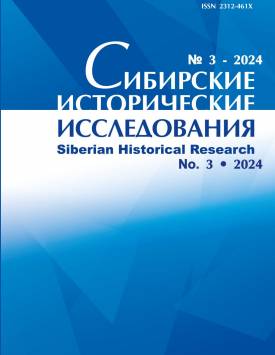Rise and Fall of Master Arthur Gleye (From the History of Linguistic Studies at Tomsk University)
The name of Tomsk linguist Arthur Wilhelm Gleye is almost completely forgotten. Meanwhile, this scholar was educated by major linguists and such classics as Karl Brugmann, August Leskien, Jan Baudouin de Courtenay, and others. All activities of Gleye date back to the 1890s-1930s, and some of his hypotheses about the ancient contacts between Uralic, Kartvelian, Semitic, and Indo-European languages, about the relationship of the Hurro-Urartian with the East Caucasian etc., even anticipated the research and conclusions of scholars of subsequent generations. However, his other works, especially in the field of Finno-Ugric studies, sharply diverge methodologically from academic comparative studies, which was the reason for the linguist’s criticism by authoritative specialists of his time, for example, Paul Ariste, who called Gleye’s activities “pseudo-linguistics.” Many of the breaks in Gleye’s career are explained by his origins from a family of Baltic Germans and the difficult times in which he lived (anti-German sentiment in the First World War, Fennomania in the Baltic countries, etc.). The article is the first to attempt to reconstruct a complete biography of the researcher from scattered fragments. The most important sources were eyewitness accounts (Kai Donner, Friedrich Knauer), as well as correspondence, including unpublished letters from Arthur Gleye addressed to Nikolai Marr, which are stored in the St. Petersburg branch of the Archive of the Russian Academy of Sciences. The author declares no conflict of interests.
Keywords
Uralo-Altaic,
Caucasus studies,
history of linguistics,
Arthur Gleye,
Kai Donner,
Nikolai MarrAuthors
| Kuznetsova Rita Sh. | Kuban State University; Institute of Linguistics of the Russian Academy of Sciences | r.kuznetsova@iling-ran.ru |
Всего: 1
References
Алишина Г.Н. Немцы Томска в конце XIX - начале ХХ в.: "немецкий след" в пространстве города // Вестник Томского государственного университета. История. 2005. № 5 (37). С. 86-90.
Ачарян Р. Корневой словарь армянского языка: в 4 т. Ереван, 1971-1979 (на арм. яз.).
БД "Профессора и преподаватели российских университетов (вторая половина XVIII -начало XX в.)": Глейе Артур Карлович (1867-*). URL: http://persons.russianuniversityhistory.tsu.ru/ (дата обращения: 21.11.2023).
Бекштрем А.Г. Загадочный диск // Журнал Министерства народного просвещения. 1911. № 12. С. 549-603.
Глейе А.К. О происхождении грузинского народа и его языка // СМОМПК. Вып. 27. Тифлис, 1900. С. 113-122.
Глейе А.К. О месте армянского языка среди арио-европейских языков // СМОМПК. Вып. 31. Отд. 4. Тифлис, 1902а. С. 1-7.
Глейе А.К. Арио-европейские, а в частности иллирийские элементы в грузинском языке // СМОМПК. Вып. 31. Отд. 4. Тифлис, 1902b. С. 8-20.
Глейе А К. Опыт решения "ванского" (урартского) вопроса // СМОМПК. Вып. 37. Тифлис, 1907a. С. 18-48.
Глейе А.К. К праистории северо-кавказских языков // СМОМПК. Вып. 37. Тифлис, 1907b. С. 49-90.
Глейе А.К. Открытое письмо г. начальнику Русского отдела проф. Ивану Ферапонтьевичу Юпатову // Новый голос. 28.05.1931. № 116. C. 2.
Груздева Е.Н. "В центре сибирского мира благоденствую под бдительной опекою полиции..".: Письма Ф.И. Кнауэра из томской ссылки 1915-1917 гг. Часть 1 (письма 1-7) / под. к публ., предисл. и ком. Е.Н. Груздевой // Письменные памятники Востока. 2020. Т. 17, № 3 (Вып. 42). С. 137-156.
Гулия Д.И. История Абхазии. Т. 1. Тифлис, 1925.
Дьяконов И.М. Языки древней Передней Азии. М., 1967.
Дьяконов И.М., Старостин С.А. Хуррито-урартские и восточнокавказские языки // Древний Восток. Этнокультурные связи. М., 1988. С. 164-207.
Климов Г.А. Этимологический словарь картвельских языков. М., 1964.
Климов Г.А. Древнейшие индоевропеизмы картвельских языков. М., 1994.
Кобычев В.П. Некоторые вопросы этногенеза и ранней этнической истории народов Кавказа: финно-угры на Кавказе // Кавказский этнографический сборник. IX. Вопросы исторической этнографии Кавказа. М., 1989. С. 10-37.
Личный состав учебных заведений Сибири, Приамурья и Туркестана 1904 г. URL: https://dzen.ru/media/id/5eee495659f4f25be9052961/lichnyi-sostav-uchebnyh-zavedenii-sibiri-priamuria-i-turkestana-1904-60117e0e20625351f7c350de (дата обращения: 21.11.2023).
Марр Н.Я. Основные таблицы к грамматике древнегрузинского языка. С предварительным сообщением о родстве грузинского языка с семитическими. СПб., 1908.
Пайазат А. Ключ халдского языка. Ереван, 1936 (на арм. яз.).
Цоя С.А. Русский институт университетских знаний: страницы истории. Рига, 2016 (Русский мир и Латвия: альманах. Вып. 44).
Ariste P. Ebakeeleteadus // Tarvel, Peeter (peatoim). Eesti Entsüklopeedia: täiendusköide. Tartu, 1940. Lk 209-210.
Donner K. Sekalaista Siperiasta [1911]. URL: https://jatkokertomukset.blogspot.com/2014/05/kai-donner-sekalaista-siperiasta.html (дата обращения: 21.11.2023).
Eisenberg J. The Phaistos Disk: A One Hundred-Year-Old Hoax? // Minerva. July/August 2008. Pp. 9-24.
Gleye A. Beitrage zur Entwicklungsgeschichte der indogermanischen "Postlingualreihen" (Gutturalreihen): lnaugural-Dissertation zur Erlangung des Grades eines Magisters der vergleichenden Sprachkunde. Jurjew (Dorpat), 1896.
Gleye A. Die ethnologische Stellung der Lykier. Helsingfors, 1900 (Helsingfors: Druckerei der finnischen Literaturgesellschaft).
Gleye A. Hettitische Studien I. Leipzig, 1910.
Gleye A. Kretische Studien I; die westfinnische lnschift auf dem Diskus von Phaestos. Tomsk, 1912 (Известия Императорского Томского университета. Кн. 47).
Gleye A. Kretische Studien III; die Sprache der Eteokreter. Riga, 1928.
Gleye A. Unser Weg. Riga, 1933.
Gleye A. Die Wiedergeburt der westfinnischen Geisteskultur. Die Urbewölkerung Europas - westfinnischen (hyperboräischen) Ursprungs; Westfinnische Denkmäler vom hohen Norden bis zum aegyptischen Süden, besonders in Kreta. Tallinn, 1937.
Hrozny F. Die Sprache der Hethiter, ihr Bau und ihre Zugehörigkeit zum indogermanischen Sprachstamm. Leipzig, 1917.
Hübschmann H. Ueber die Stellung des Armenischen im Kreise der indogermanischen Sprachen // Zeitschrift für vergleichende Sprachforschung auf dem Gebiete der Indogermanischen Sprachen, 23. Bd., 1. H. (1877). P. 5-49.
Jensen P. Hittiter und Armenier. Strassburg, 1898.
Munkácsi B. Kaukasischer Einfluss in den Finnisch-Magyarischen Sprachen // Keleti Szemle/Revue orientale. 1900. Vol. 1. P. 38-49, 114-132, 205-218.
Munkácsi B. Arja és kaukázusi elemek a Finn-Magyar nyelvekben. Budapest, 1901.
Pauli C. Eine vorgriechische Inschrift von Lemnos. Teil 2. Leipzig, 1894.
Saks E. Esto-Europa: A Treatise on The Finno-Ugric Primary Civilization in Europe: Studies in Ur-European history II. Montreal; Lund, 1966.
Stolypin P.A., Kriwoschein A. W. Die Kolonisation Sibiriens. Eine Denkschrift. Einzige berechtigte Ubersetzung von Carl Erich Gleye. Berlin, 1912.
Trombetti A. Delle relazioni delle lingue caucasiche con le lingue camitosemitiche e con altri gruppi linguistici // Giornale della Società Asiatica Italiana. Voll. XV-XVI (Firenze, 1902-1903). P. 177-201, 145-175.
Villandi M. Pseudolingvistika kui folkloorinähtus // Mäetagused: Hüperajakiri. 2014. № 58. Lk 125-146.
Winkler H. Der Uralaltaische Sprachstamm, das Finnische und das Japanische. Berlin, 1909.

